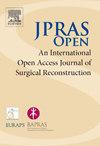Novel ‘mini-incision’ metacarpal fixation technique for long oblique and spiral shaft fractures
IF 1.5
Q3 SURGERY
引用次数: 0
Abstract
Background
Metacarpal shaft fractures account for 30 % of all hand fractures, and long oblique and spiral shaft fractures represent a significant quantity. Closed or open reduction and internal fixation is generally indicated for unstable fractures, rotational malalignment or significant metacarpal shortening. Various techniques can achieve appropriate fixation, though no single technique has been proven to be superior across all cases. The choice of fixation often depends on the fracture pattern, surgeon expertise and patient factors.
Objectives
This large series aimed to show that our novel technique can achieve excellent clinical and aesthetic outcomes for metacarpal fractures despite being inferior in biomechanical studies.
Methods
Briefly, 120 fractures in 115 hands were included in centres across Ireland and Saudi Arabia between 2016 and 2022. Inclusion criteria were patients with long oblique and spiral metacarpal mid-shaft fractures with significant displacement, metacarpal shortening and/or rotational malalignment. Fixation was achieved via cerclage wires inserted through a minimal dorsal incision. We examined the clinical and radiological outcomes of these patients.
Results
We observed excellent results in our cohort, with 92.5 % of the patients obtaining full passive and active range of motion at the final follow-up. The mean qDASh score was 4.5. There was 1 case of malunion and 1 wire migration. No patients had cosmetic concerns regarding the dorsal hand scars.
Conclusion
Our novel metacarpal cerclage can help patients regain excellent range of motion and avoid extended immobilisation. We believe that this method is technically simple, forgiving to mistakes, affordable and can provide excellent cosmesis
求助全文
约1分钟内获得全文
求助全文
来源期刊

JPRAS Open
Medicine-Surgery
CiteScore
1.60
自引率
0.00%
发文量
89
审稿时长
22 weeks
期刊介绍:
JPRAS Open is an international, open access journal dedicated to publishing case reports, short communications, and full-length articles. JPRAS Open will provide the most current source of information and references in plastic, reconstructive & aesthetic surgery. The Journal is based on the continued need to improve surgical care by providing highlights in general reconstructive surgery; cleft lip, palate and craniofacial surgery; head and neck surgery; skin cancer; breast surgery; hand surgery; lower limb trauma; burns; and aesthetic surgery. The Journal will provide authors with fast publication times.
 求助内容:
求助内容: 应助结果提醒方式:
应助结果提醒方式:


